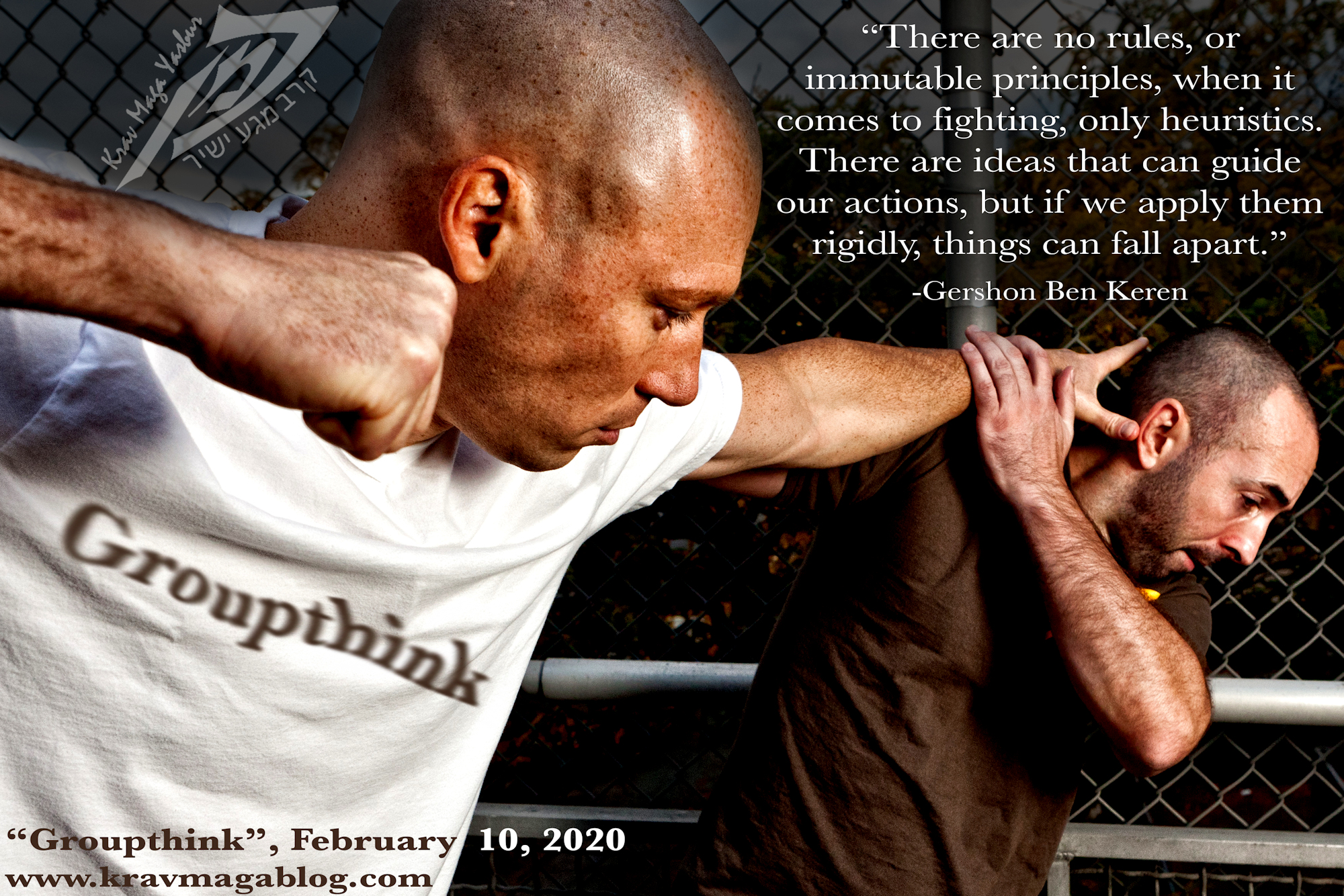The term “groupthink”, is a term taken by Irving Janis (1972) from George Orwell’s “1984”, that refers to a psychological phenomenon, whereby individuals start to think in the same way for reasons of conformity and harmony, rather than because they have individually come to the consensus decision. When this happens, alternative solutions to problems and issues aren’t considered, because the “ingroup” has already decided what the “correct” solution is and have convinced themselves that everything else is wrong. For much of my early life in the martial arts, the “groupthink” attitude was that striking arts were superior to grappling arts; it wasn’t that grapplers didn’t recognize the importance of striking, but the predominant view of the striking arts was that grapplers could be kept at range through striking, etc. That was the “groupthink” when I was growing up - and then Royce Gracie – a Ju-Jitsu practitioner – won the first UFC in 1993, not just by grappling, but by grappling on the ground. This was followed by a period in the sport where wrestlers/grapplers dominated. Unfortunately, the way that our brains manage information, makes us prone to “groupthink”, and as martial arts/self-defense practitioners we need to be aware of this, as it can narrow our thinking, and make us prone to believing that what we have been taught is the only and/or “correct” solution and everybody else has got it wrong.
There are no rules, or immutable principles, when it comes to fighting, only heuristics. There are ideas that can guide our actions, but if we apply them rigidly, things can fall apart. One of the first principles of Krav Maga I learnt was: if it’s a life-threatening attack (such as a choke or strangulation), attack the attack, if it’s a non-life-threatening attack (such as a wrist or lapel grab), attack the attacker. This is a fantastic guiding concept/idea, but it isn’t necessarily the best strategy in every situation e.g. in some instances – such as when dealing with an aggressive group - if you’re grabbed, it may be better to free yourself and disengage, rather than attack your attacker, and in others if an assailant has you by the lapels and is throwing you around, it may not be possible to strike them, and you will need to free yourself first, etc. Having, and adhering, to absolutes, forces you to respond in a fixed way, and may prevent you from utilizing a solution that is applicable and relevant in that moment. In the early days of the UFC, many strikers ignored the fact that even if they weren’t going to utilize grappling solutions, they needed to understand grappling in order to ensure that their striking options would work. There must come a point in our training where we look outside of what we’ve been taught, and question our approach, not to convince ourselves that what we’ve been taught is correct, but to critically evaluate our solutions and see if they marry up with reality, even if this means that we may not conform to our group’s and/or instructor’s position. In a real-life encounter, you aren’t there to demonstrate and promote the applicability of your system or style, you’re there to use what you’ve been taught to survive the situation i.e. if you think that you will be cleanly replicating the techniques you’ve been taught in a familiar a-b-c pattern, you have an unrealistic expectation of what violence looks like.
We are prone to “groupthink” due to the way that our brain categorizes information i.e. we sort information into silos and aren’t very good at managing data/information that doesn’t neatly fit into categories. This is one of the reasons why we don’t like it when we ask a question, such as what we should do in this or that situation and our instructors says “it depends” i.e. we want a clear-cut answer that we can put in the appropriate box. Solutions to violence can’t be applied in a paint-by-numbers fashion, whereby every time we are attacked in a certain way, we respond in an identical fashion – there are just too many variables in real-life confrontations to operate this way e.g. multiple attackers, the environment we are in, people and dependents who are with us, etc. If we consider a typical street robbery, statistically it will involve multiple assailants – what will they be doing as you attempt to disarm a weapon? Situations determine solutions, not the “techniques” you have learnt; even though our brains want to manage the solutions we have learnt otherwise. The terminology and phraseology that is often used in self-defense can exacerbate this, such as using terms like “always” and “never”, etc.
In defining religious “cults” there are seven signs/criteria that are commonly used, and some are useful to judge whether we are thinking independently or whether we are blindly adhering to an instructor’s or association’s message. Firstly, is critical thinking opposed i.e. if you question a technique or solution presented to you, how does your instructor/association deal with it? Is it dismissed without consideration? Does your instructor appear annoyed or respond aggressively? Secondly, how does your instructor respond to individuals who leave your school to train elsewhere, possibly in another style or system? The martial arts for me has always been about finding your individual way, and I recognize that what and how I teach isn’t what everybody is looking for, or necessarily needs. In religious terms, cults emphasize special/secret doctrines outside of scripture, in martial arts/self-defense terms, schools and associations that promote the idea that their system or style, has secret techniques, should be seriously questioned. For some reason these are usually “killing techniques” reserved for the true disciples – in the thousands of years of man’s existence, if somebody is claiming that they have discovered a new and unknown way to kill a person, you’re talking to a snake oil salesman. The fourth criteria in religious cults is inappropriate loyalty to its leaders; something in my forty years in the martial arts that has been all too common e.g. the head instructor and their ideas are beyond question. There is a huge difference between having respect for somebody’s experience, etc., and being encouraged to idolize them. The last three criteria are specific to religious organizations, however the first four are applicable to any group, and if you feel/believe that you are being encouraged and directed to think in these ways, it may be time to start questioning things.
Humans like to be part of groups, however when we join one, we need to recognize that we will by default start to think and believe the group message and question that of those outside the group. This isn’t by any sinister design, it’s how we are programmed to behave. However, we should be aware of this and recognize that to critically think we must actively work against it. One way is to expand the groups we are part of and interact in a healthy manner with individuals who are part of other groups, rather than double down and reinforce our own belief systems with that of the group.
Share:

Gershon Ben Keren
2.8K FollowersGershon Ben Keren, is a criminologist, security consultant and Krav Maga Instructor (5th Degree Black Belt) who completed his instructor training in Israel. He has written three books on Krav Maga and was a 2010 inductee into the Museum of Israeli Martial Arts.
Click here to learn more.

